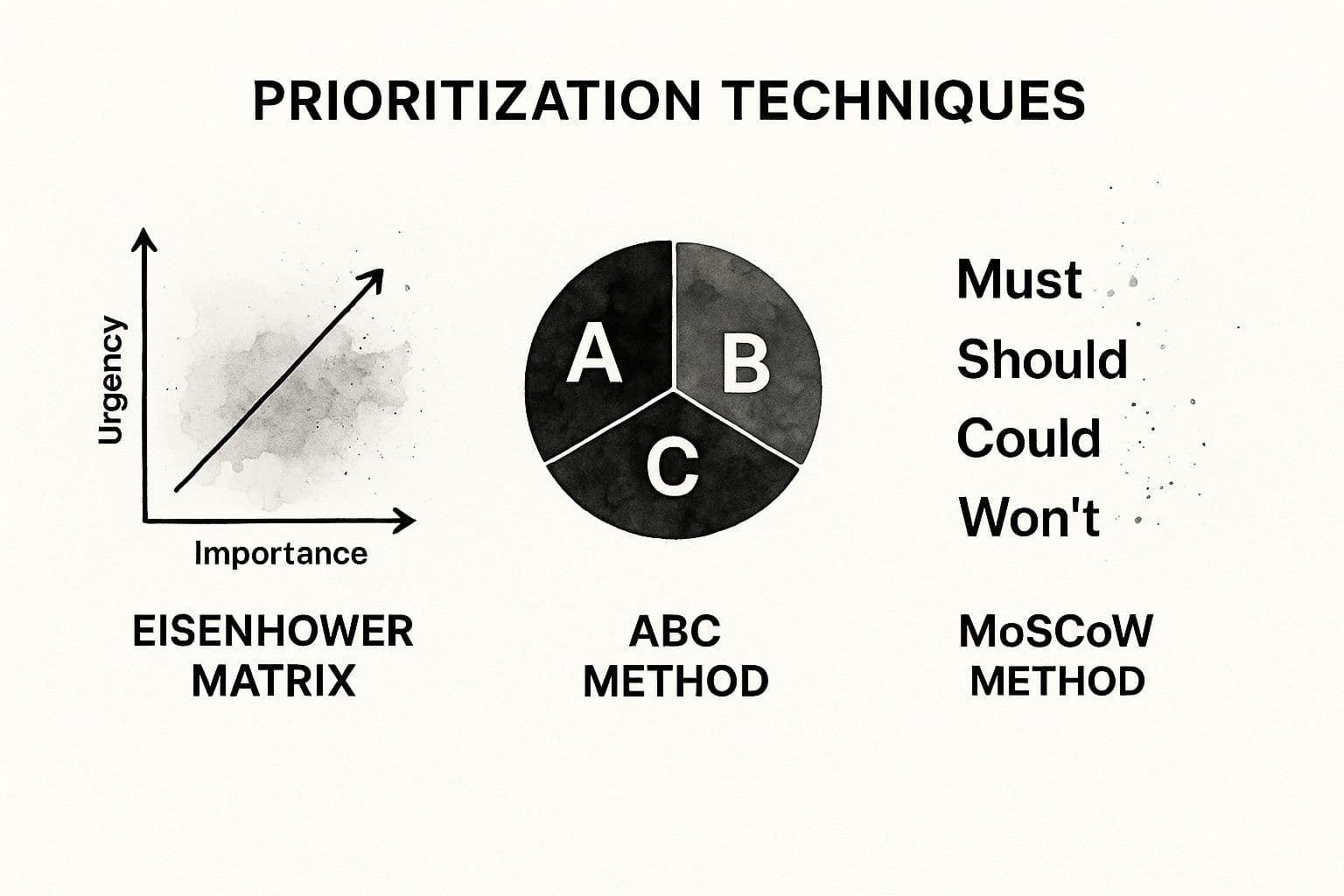Feeling overwhelmed? Learn how to manage competing priorities with our expert guide. Discover proven frameworks and communication strategies for real results.
Do less, be more with Fluidwave
Fluidwave combines smart task prioritization with an assistant marketplace — AI and human help, all in one productivity app.
July 9, 2025 (4mo ago)
How to Manage Competing Priorities and Stay Focused
Feeling overwhelmed? Learn how to manage competing priorities with our expert guide. Discover proven frameworks and communication strategies for real results.
← Back to blog
When you're juggling multiple demands at once, managing competing priorities is all about systematically deciding where to focus your attention. The real shift happens when you move from simply reacting to urgent requests to proactively aligning your work** with what actually drives success for your projects and the business.
Why It Feels Impossible to Manage Competing Priorities

If you feel like you’re constantly juggling and inevitably dropping a few balls, you're in good company. This struggle is rarely a personal failing. More often than not, it's a symptom of systemic issues within an organization that put dedicated professionals in impossible situations. It’s a universal challenge, really, rooted in the nature of modern work where resources are finite but expectations seem limitless.
Picture this: You’re a project manager, completely dialed in on hitting a critical deadline for a product launch. Out of nowhere, an urgent email from the CEO hits your inbox. They need a new report for a board meeting—and the deadline is tomorrow. This new request is obviously urgent and comes from the highest level, but your current priority is crucial for the company's long-term goals. What do you do?
The Real Reasons for the Overwhelm
This kind of daily conflict isn't just about having "too much to do." It’s fueled by deeper organizational dysfunctions that create constant friction. Getting to the root of these issues is the first real step toward finding a way out of the chaos.
The main culprits behind this struggle usually include:
- Conflicting Stakeholder Demands: Different leaders and departments often have their own agendas. When your work supports multiple stakeholders, you get caught in the crossfire of their competing needs.
- Unclear Strategic Direction: Without a clear "North Star" from leadership, every task can feel like a top priority. This ambiguity forces you and your team to guess what matters most, which often leads to wasted effort and frustration.
- Resource Constraints: Let's be honest—projects are frequently planned with a healthy dose of optimism, not a realistic assessment of the time, budget, or people available. This sets teams up to make tough trade-offs between scope, quality, and deadlines from day one.
The core problem is that many professionals are judged on their ability to handle every incoming request, rather than on their ability to strategically prioritize and protect what's most impactful. This creates a culture of reactivity.
Shifting From “Working Harder” to Working Smarter
The answer isn't to work longer hours or just try to be faster. That path only leads to burnout and sloppy work. The real solution lies in reframing the problem entirely.
Learning to manage competing priorities is less about time management and more about strategic negotiation and clear communication. It’s about making a fundamental shift from a reactive to a proactive mindset. You need a framework that helps you assess new requests, align them with established goals, and communicate your capacity with confidence.
When you do that, you start to regain control, ensuring your efforts lead to meaningful outcomes. You also prove that working smarter delivers far better results than just working harder ever could.
Aligning Your Work with What Truly Matters

Before you can start juggling priorities, you need to know which balls are made of glass. Without that clarity, every task feels urgent, and you're left making decisions based on who shouted the loudest. The single most effective way I've found to cut through the noise is to tie my day-to-day work directly to the bigger picture—what the company is actually trying to accomplish.
This isn't about memorizing the mission statement. It’s about building a practical compass you can use every single day. That starts by getting crystal clear on the metrics that leadership uses to measure success.
Finding Your North Star
Think of your "North Star" as the one key metric that perfectly captures the value your team provides. For a marketing team, it might be qualified lead generation. For engineers, maybe it’s daily active users. Once you identify this, you have an incredibly powerful filter for every new request that lands on your plate.
If you don't know your North Star, finding it becomes your top priority. Seriously. Start a conversation with your manager. I've found that asking specific questions works best:
- "To make sure my work has the biggest impact, what's the single most critical outcome for our team this quarter?"
- "When we look back in six months, what's the one result that will make us feel we've truly succeeded?"
- "If we could only move the needle on one metric, what would it be?"
The idea is to get away from vague goals and lock in something concrete and measurable. This changes everything, giving you a solid foundation for every "yes" or "not right now."
Aligning with Stakeholders
Once you have your own clarity, it's time to get everyone else on the same page. This is where the real work begins. Misalignment between you and your stakeholders is a massive source of friction. It’s no surprise that companies with tightly aligned priorities see project success rates jump by as much as 25%.
On the flip side, a 2023 survey revealed that over 60% of project managers blamed competing priorities for project delays. It's a costly problem, and you can read the full research on competing priorities at Businessmap.io to see just how deep the issue runs.
Never assume everyone is on the same page. Proactive alignment isn't a one-time meeting; it's a continuous conversation you need to lead.
So, how do you do this in practice? Start bringing your North Star metric into your project discussions.
When a new task appears, your response can change from a simple, "When do you need this?" to something more strategic like, "Can you help me understand how this task moves us closer to our goal of improving qualified lead generation?"
This small shift forces a more strategic conversation. It helps the person making the request see how their task fits (or doesn't fit) into the grand scheme of things. It also gives you a much stronger position for negotiating deadlines or pushing back on work that’s just a distraction.
A shared understanding of what truly matters is your best defense against the constant pull of competing demands. Of course, getting your calendar organized is another huge piece of the puzzle. We have a guide on using a time management calendar to maintain focus that can help with that.
Choosing the Right Framework for Daily Decisions
Once you’ve connected your daily work to the big-picture goals, you're faced with the real battle: managing the relentless flow of tasks. Theory is one thing, but you need a practical system to figure out what to tackle now, what to schedule for later, and what to politely decline. This is where a good prioritization framework becomes your secret weapon.
Instead of just reacting to the latest email or going with your gut, a framework gives you a consistent, objective way to look at every single task. It helps you answer the all-important question, "What's the absolute best use of my time right now?" For anyone juggling competing demands, this kind of systematic approach is a game-changer.
The Eisenhower Matrix for Urgency and Importance
One of the most battle-tested and effective frameworks out there is the Eisenhower Matrix. It’s brilliant in its simplicity, helping you sort tasks based on just two things: urgency and importance. This distinction is critical because, as we all know from experience, the loudest tasks aren't always the most valuable.
It's no surprise that managing competing priorities is a huge challenge. The Project Management Institute (PMI) consistently finds it's a top hurdle for project managers dealing with tight deadlines and demanding stakeholders. Frameworks like the Eisenhower Matrix are designed to cut through that noise, separating the "fires" that need immediate attention from the strategic work that actually moves the needle. You can find more expert advice on navigating priorities at Tempo.io to see how these methods work in complex project environments.
Here's how you can put the matrix to work for you:
- Urgent & Important (Do First): These are your true crises and non-negotiable deadlines. Think of a critical server outage or the final report for your biggest client that's due this afternoon.
- Not Urgent & Important (Schedule): This quadrant is where real progress happens. It's for strategic planning, building key relationships, and long-term projects. You have to be disciplined about blocking out time for these, or they'll get swallowed by the urgent but less important stuff.
- Urgent & Not Important (Delegate): These are the interruptions that feel important but don't align with your core goals. Think scheduling a routine team meeting or fielding a non-critical request. If you can delegate it, do it.
- Not Urgent & Not Important (Eliminate): These are the time-wasters and distractions. The key here is to get better at recognizing and consciously cutting these activities out of your day.
The image below gives you a great visual comparison of the Eisenhower Matrix and other popular techniques.

As you can see, different frameworks are built for different jobs, from the Eisenhower Matrix’s focus on urgency to the MoSCoW method’s role in defining project requirements.
MoSCoW and RICE for Project and Product Decisions
While the Eisenhower Matrix is fantastic for sorting out your personal to-do list, other frameworks are tailored for team decisions, especially when it comes to projects and products.
The MoSCoW method is a lifesaver for clarifying project scope and getting everyone on the same page. It helps you categorize features or tasks into four simple groups:
- Must-Have: These are the absolute essentials. The project is a failure without them.
- Should-Have: Important, but not critical. The project can still launch successfully if these are delayed.
- Could-Have: These are the "nice-to-have" features you’ll add if time and resources allow.
- Won't-Have: Items that are officially out of scope for this round, preventing future confusion.
This approach brings immediate clarity and is your best defense against the dreaded "scope creep."
For product teams, the RICE scoring model offers a more quantitative approach. It scores potential new features using four factors: Reach, Impact, Confidence, and Effort. By running the numbers, teams can make objective calls about which ideas will deliver the most bang for the buck.
A classic example is a product manager stuck between two features. One is a major request from a single, large client (low Reach, high Impact). The other is a minor improvement that would benefit every user (high Reach, low Impact). RICE gives you a formula to make that call with data, not just emotion.
To make it easier to pick the right tool for the job, here’s a quick guide comparing these popular models.
Choosing Your Prioritization Framework
A framework isn't a one-size-fits-all solution; the best one depends on what you're trying to accomplish. This table breaks down three popular models to help you choose the right one for your specific needs.
| Framework | Best For | Key Benefit |
|---|---|---|
| Eisenhower Matrix | Daily personal task management and quick decision-making. | Separates urgent distractions from important strategic work. |
| MoSCoW Method | Defining project scope and managing stakeholder requirements. | Creates clear boundaries and prevents scope creep. |
| RICE Scoring | Product teams prioritizing features and initiatives. | Provides a data-informed, objective way to compare options. |
Ultimately, the best framework is the one you'll actually use. An individual contributor might find the Eisenhower Matrix is all they need to stay on track, whereas a project lead will lean heavily on the MoSCoW method to keep their team focused and their stakeholders happy.
Mastering Communication with Stakeholders

Even the best prioritization system in the world can fall apart without good communication. Once you have a clear handle on your own priorities, the real work begins: getting everyone else on the same page. From my experience, managing competing demands is often less about your personal to-do list and more about skillfully managing stakeholder expectations.
It’s about making a crucial shift. Instead of constantly reacting and defending your choices, you need to proactively build alignment and trust from the very beginning. Simple, consistent communication is your best defense against those last-minute "emergencies" and the dreaded scope creep.
Proactive Strategies to Build Trust
The easiest way to deal with conflict? Stop it before it even starts. Proactive communication positions you as a strategic partner, not just someone who checks off tasks. It shows stakeholders you're on top of things and that their projects are in capable hands.
Here are a couple of incredibly simple but effective tactics I’ve used:
- Regular Progress Updates: A brief weekly email can work wonders. Just a quick summary of progress, upcoming milestones, and any potential risks for your key projects. This transparency keeps everyone in the loop and stops them from chasing you for updates.
- Simple Project Dashboards: I'm a big fan of using tools like Fluidwave, Trello, or Asana to create a shared, visual project board. When a stakeholder can see the current task list and its priority level for themselves, they have instant context for any new ideas they bring to the table.
The goal is to make your priorities visible. When stakeholders can see the full picture of your workload, they are much more likely to understand the trade-offs required when they ask for something new.
Scripts for Navigating Difficult Conversations
Of course, you can't prevent every conflict. The real test comes when a stakeholder drops a huge, unexpected request right in the middle of a project. How you handle that moment can either strengthen your relationship or create lasting friction.
Your goal shouldn't be a flat "no." It should be collaborative problem-solving. It’s a delicate balance, and we have a full guide that can help you stay focused when these situations arise.
Here's how I approach that conversation:
Scenario: A stakeholder wants to add a major new feature to an already packed sprint.
Your Response: "That's an interesting idea, and I can definitely see how it would add value. Right now, the team is fully focused on delivering X and Y to meet our launch deadline. To get this done, we would need to either push the launch date back or remove one of the current features. Which of those options would you prefer to explore?"
This approach changes the entire dynamic. You aren't just saying no. You're presenting a clear choice and forcing a conversation about trade-offs. You're bringing the stakeholder into the decision-making process, making them weigh their new request against existing commitments.
It reinforces a simple truth: every new "yes" requires a "no" somewhere else. This turns a potential argument into a shared strategic decision. This is how you truly manage competing priorities.
Using Technology to Gain Clarity and Control
Frameworks and clear communication are foundational, but let's be honest—they can only take you so far. To truly master competing demands, you need the right technology to back up your strategy. The idea isn't to just add another app to your tech stack. It's about finding a system that makes your priorities tangible—something visible, shareable, and, most importantly, actionable for the entire team.
Without that central source of truth, even the most brilliant plans can unravel into a mess of conflicting emails and outdated spreadsheets.
Think of it this way: your prioritization framework is the map, but a solid project management tool is the GPS giving you real-time, turn-by-turn directions. It shows you exactly who is working on what, helps you spot potential roadblocks before they become emergencies, and gives you a realistic view of your team's bandwidth. This is how you confidently answer stakeholders when they come knocking with "just one more thing."
Creating a Central Hub for Priorities
The real magic of these tools is creating a single, shared reality for everyone. When your team and stakeholders are all looking at the same dashboard, conversations about what's really important become much more objective and a lot less about who has the loudest voice.
This is where specific features can make or break your workflow. I always recommend looking for:
- Shared Task Lists: Get everything out of personal notebooks and siloed spreadsheets. A shared list in a tool like Asana, Jira, or our own Fluidwave ensures everyone sees the same priorities in the same order. No more confusion.
- Resource Allocation Views: These are game-changers. They show you, at a glance, who is assigned to what and—critically—who is over capacity. This is your best defense against team burnout and helps you make smart, sustainable decisions about taking on new work.
- Dependency Tracking: You know how one delayed task can cause a domino effect of chaos? This feature stops that. It lets you link related tasks, so if Task A gets pushed back, the system automatically flags the impact on Task B. It makes bottlenecks visible weeks in advance.
- Real-Time Dashboards: A good dashboard gives stakeholders that high-level overview they crave without you having to constantly compile and send manual status updates. It's a win-win.
The right technology doesn't just organize your tasks; it organizes your conversations. It shifts discussions from "what I think is important" to "what the data shows is our next move."
Gaining Control Through Visibility
In any environment where you're juggling multiple projects, competing priorities almost always boil down to a fight over shared resources or conflicting stakeholder needs. It’s a huge problem. In fact, a 2020 study found that over 80% of organizations struggle with resource management, leading directly to major project delays.
This is where technology gives you the visibility needed to take back control.
Imagine this scenario: a stakeholder comes to you with an "urgent" request. Instead of a difficult negotiation, you can simply show them a real-time Kanban board illustrating that the team is at full capacity. Suddenly, the conversation changes. It's no longer you saying "no"; it's the data showing "not right now." This kind of transparency builds trust and transforms contentious debates into collaborative problem-solving.
By leaning on these systems, you shift from a constant state of reaction to one of proactive, data-driven leadership. To go deeper on this, check out our guide on essential task prioritization techniques.
Common Questions About Managing Priorities
It’s one thing to read about priority management strategies, but putting them into practice is where the real learning happens. When you start applying these ideas to your day-to-day work, you're bound to run into some tricky situations.
Let's walk through a couple of the most common challenges I've seen professionals face and how to handle them.
How Do I Handle a Truly Urgent and Important Task That Derails Everything?
We've all been there. It's the classic "fire drill" scenario—an unexpected, high-stakes task lands on your desk and threatens to throw your entire day, or week, off track.
The first instinct might be to drop everything, but your initial move should be to act as a gatekeeper. Before you pivot, take a breath and quickly assess the real impact. Ask yourself: "What are the immediate, tangible consequences if this isn't handled right now?"
If it's a genuine crisis—think a critical system failure or a major client issue—the answer is obvious. You have to shift gears. The key is immediate communication. Let the stakeholders on your other projects know what's happening.
A simple, direct message goes a long way: "A critical issue has come up that needs my full attention. I'm pausing work on Project X for now and will send an updated timeline by the end of the day." This manages expectations and prevents the chaos that comes from radio silence.
What if My Boss Is the Source of Conflicting Priorities?
This is a delicate situation, but incredibly common. Your manager is piling on new "top priorities" without acknowledging what's already on your plate. The solution isn't to push back by saying "I can't do that." Instead, you need to make the trade-offs visible.
Frame the conversation around capacity and impact. This shifts the dynamic from confrontation to collaboration.
"I can absolutely take on this new report. To give it the attention it deserves, should I de-prioritize the market analysis for the Q3 launch, or should I push back the competitor review? Let me know which one makes the most sense to adjust, and I'll get started on your new request."
This approach does two things beautifully. It shows you're a proactive, willing team player, but it also respectfully highlights that your time is a finite resource. You're not refusing the work; you're asking for their strategic input to realign your focus. It’s a powerful way to manage up without ever sounding uncooperative.
Ready to stop juggling and start prioritizing with real clarity? Fluidwave gives you the tools to see your workload, delegate tasks, and get your team aligned on what truly matters. Take control of your priorities today.
Do less, be more with Fluidwave
Fluidwave combines smart task prioritization with an assistant marketplace — AI and human help, all in one productivity app.